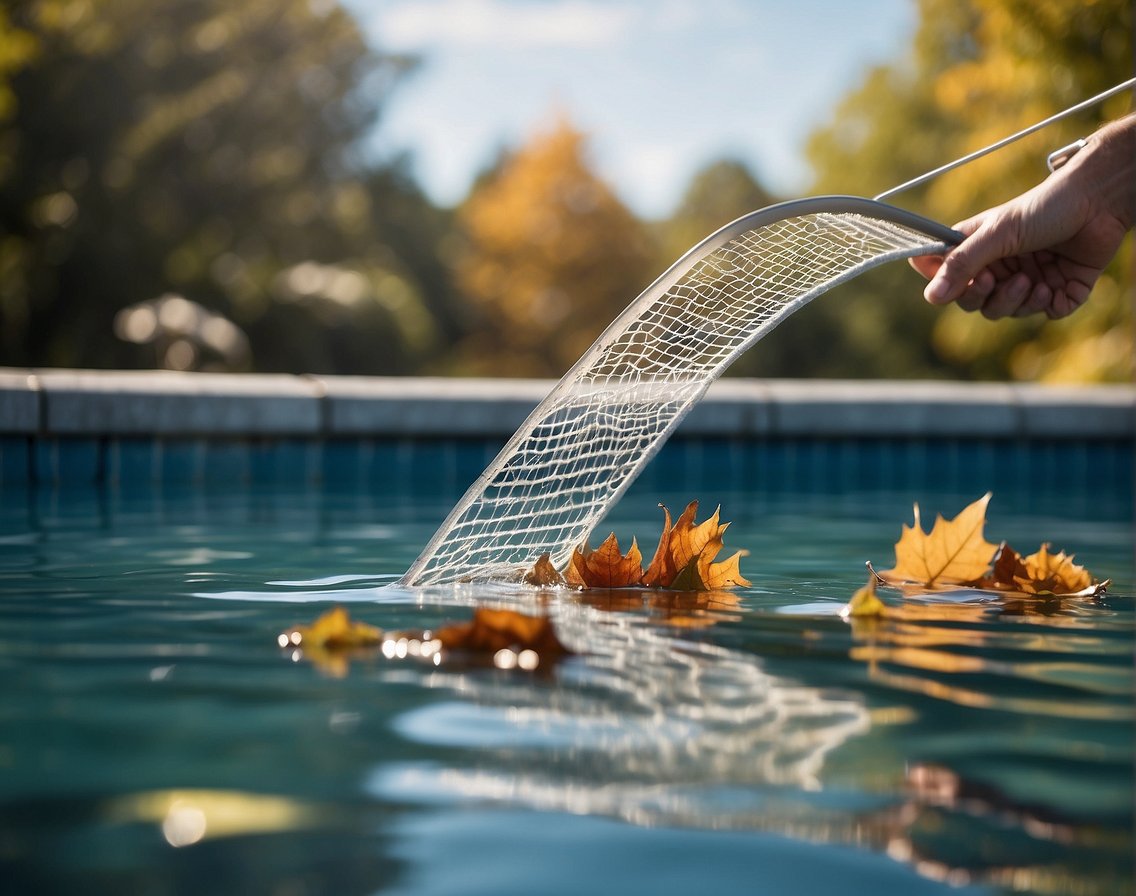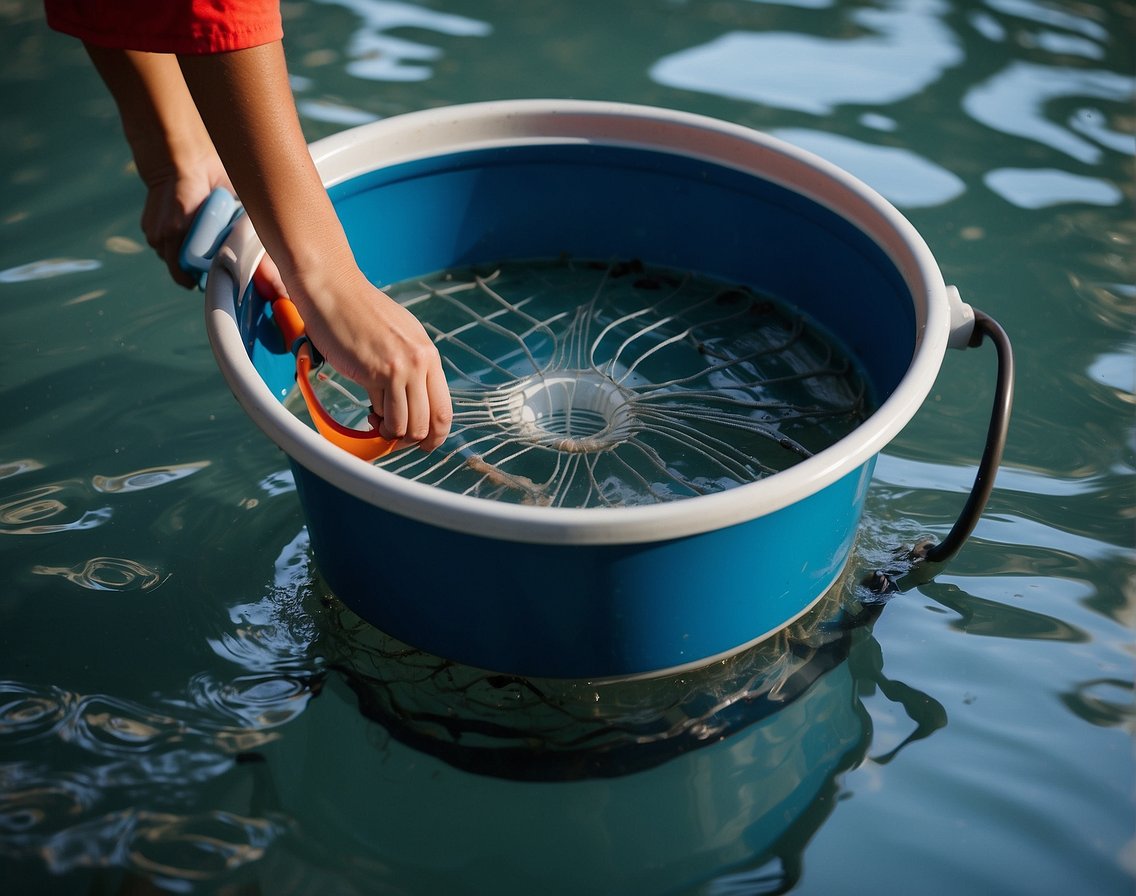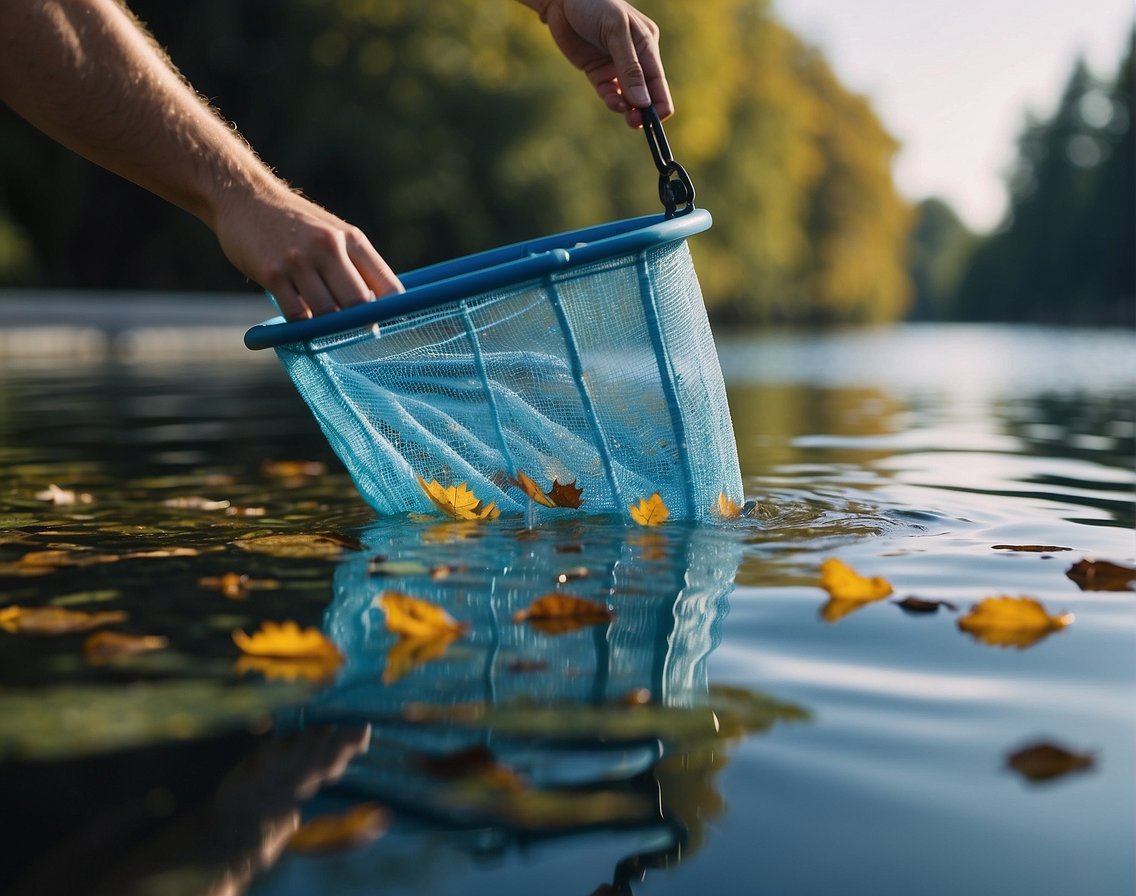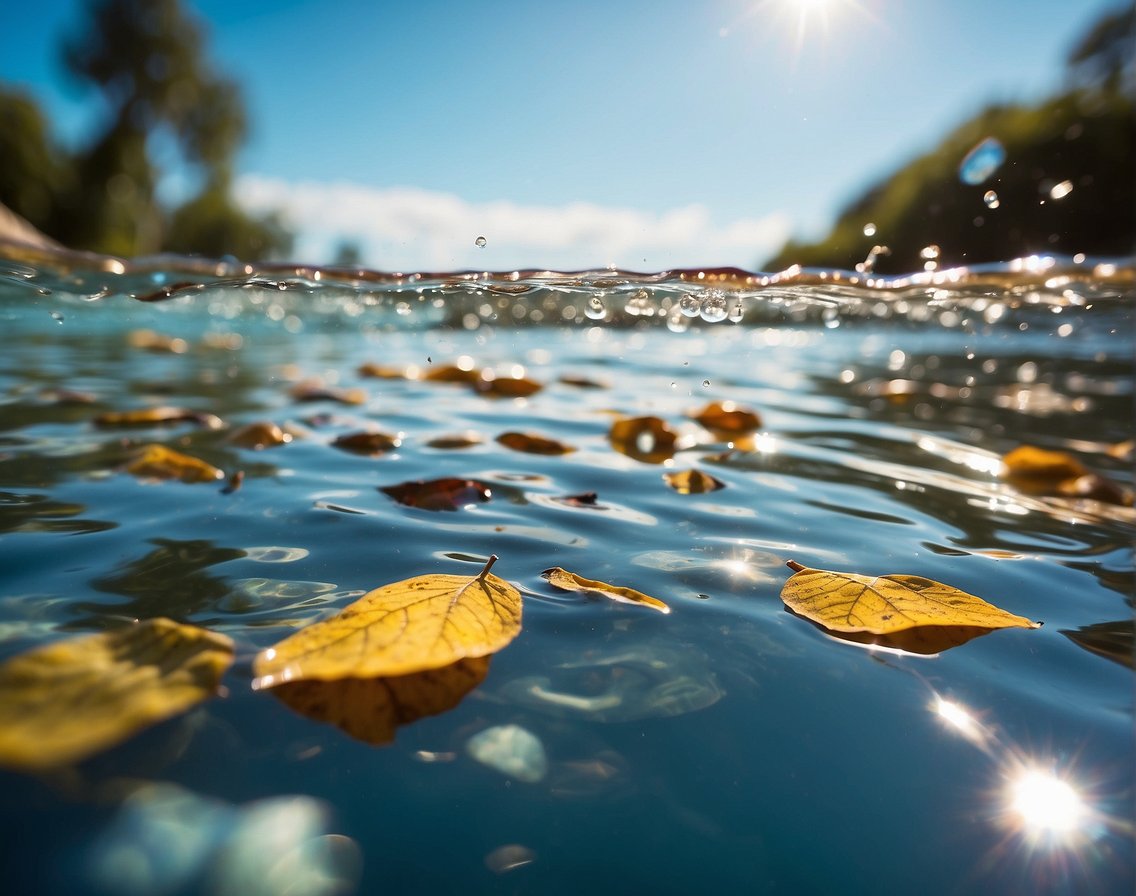Understanding Pool Skimming

Pool skimming is a vital maintenance practice that ensures clean and inviting water. It’s a primary step in the upkeep of a pool’s hygienic state by removing debris before it sinks and decomposes.
Skimming Basics
Skimming is an essential part of pool maintenance that involves the removal of leaves, bugs, and other debris from the surface of your pool water. We prioritize this task to maintain proper circulation, prevent clogging, and ensure our pool’s water remains pristine. The key components in this process are a skimmer net and a skimmer basket. As the pool owner, it’s critical to regularly clear the basket and sweep the surface with the net to optimize the skimming effectiveness.
- Daily Tasks: Using a skimmer net to remove visible debris.
- Regular Maintenance: Emptying the skimmer basket to ensure proper flow and prevent damage.
Types of Pool Skimmers
There are various skimmers available, each designed to cater to different types of pools and preferences.
- Manual Skimmers: These include a skimmer net attached to a telescopic pole, allowing us to physically capture debris from the pool’s surface.
- Automatic Skimmers: These devices, such as suction-side or pressure-side skimmers, are attached to the pool’s circulation system. They continuously move around the pool, drawing in water and floating debris into a collection basket or weir.
- Built-in Skimmers: Most pools have these skimmers integrated into their design. They consist of a skimmer basket placed within the pool’s wall, where water flows in through a weir, trapping the debris efficiently.
- Choice Consideration: Pool size, type, and amount of debris typical in your environment.
- Best Practice: Assessing your needs to decide whether manual or automatic skimming is optimal.
Preparation and Initial Steps

Before we commence the pool skimming process, it’s crucial to prioritize safety and assemble all necessary tools to ensure an efficient and effective cleaning routine.
Safety and Health Considerations
- Safety Gear: Always wear protective gloves and eyewear when handling pool chemicals to prevent irritation or harm.
- Hygiene: Shower before skimming to minimize the introduction of contaminants such as bacteria and viruses into the pool water.
Tools and Equipment Needed
Necessary Tools
- Skimmer: Essential for removing debris from the water surface.
- Telescopic Pole: A sturdy pole that extends your reach and connects to the skimmer.
- Pool Brush: Used to scrub the pool walls and floor, ensuring thorough cleaning.
- Pool Vacuum: Assists in removing dirt and debris settled at the bottom.
Vacuum Components
- Vacuum Head: Attaches to the telescopic pole for underwater cleaning.
- Vacuum Hose: Connects the vacuum head to the pump, allowing for suction.
Additional Equipment
- Net Skimmer: A net attached to a handle, handy for quick surface cleaning.
- Pump: Circulates water through the filtration system, essential for pool maintenance.
Skimming Techniques and Strategies

Effective pool skimming involves the right techniques and strategies to keep the water pristine and free of debris. We’ll explore two critical aspects: the manual skimming process and methods to enhance skimmer efficiency.
Manual Skimming
In manual skimming, we use a skimmer net attached to a telescoping pole, ensuring we can reach debris across the entire pool surface. To maximize effectiveness, we move the net steadily across the water’s surface, targeting leaves, insects, and other floating debris to remove from the pool. It’s vital to skim gently to avoid pushing debris to the bottom of the pool. Here is a step-by-step approach to manual skimming:
- Inspect the Pool: Scan the entire pool surface for visible debris.
- Position Ourselves: Stand at an angle where the wind direction can help us gather the debris in one corner.
- Slow and Steady Movements: Glide the skimmer net softly across the water’s surface.
- Remove and Clean: After each pass, shake off the collected debris from the net.
Enhancing Skimmer Efficiency
To enhance the efficiency of the pool’s built-in skimmer, we focus on improving suction and trapping finer particles:
- Clean the Skimmer Basket: Regularly empty the skimmer basket to maintain strong suction.
- Use Pantyhose: Cover the skimmer basket with pantyhose to trap finer particles without impeding water flow.
- Optimize Pool Circulation:
- Check the Jets: Position return jets downward to circulate water from the bottom to the surface, which helps propel debris towards the skimmer.
- Adjust Return Jet Angles: Create a circular water flow by angling the jets slightly to the sides, increasing the efficiency of debris collection.
Remember, keeping our pool clean is not just about skimming; we also need to ensure that the pool’s circulation systems are working optimally to assist in the cleaning process.
Maintaining Water Chemistry and Cleanliness

Proper pool maintenance hinges on two crucial components: the balance of pool chemicals and a robust strategy for preventing contamination. We’ll guide you through these to ensure optimal water quality and hygiene for your swimming pool.
Chemical Balancing
The foundation of pool water maintenance is achieving the correct chemical balance. Regularly test pool water to maintain chlorine levels between 1-3 ppm (parts per million) to effectively sanitize the pool without causing irritation. Keep pH levels between 7.2 and 7.8; this range is optimal for swimmer comfort and chlorine effectiveness. Total alkalinity, which should be within 80-120 ppm, supports stable pH levels and prevents fluctuations. Lastly, maintain calcium hardness around 200-400 ppm to protect pool equipment and minimize surface erosion.
Here are the acceptable ranges for maintaining pool chemistry:
- Chlorine: 1-3 ppm
- pH level: 7.2 – 7.8
- Total Alkalinity: 80-120 ppm
- Calcium Hardness: 200-400 ppm
Remember, improper balancing can lead to problems such as algae growth, skin irritation, and damage to the pool surfaces or equipment.
Preventing and Addressing Contamination
To prevent contamination from algae, bacteria, viruses, and other organic materials, we must be vigilant in our cleaning routines. Regularly skimming the pool removes debris, while brushing and vacuuming prevent the buildup of contaminants on pool surfaces. A sanitizing schedule using pool chemicals, such as chlorine or bromine, is imperative to disinfect the water and inhibit the growth of harmful organisms. Super chlorination or “shocking” the pool weekly helps in maintaining water clarity and preventing algae growth.
For tackling contamination, adhere to the following:
- Skim the pool surface daily to eliminate debris.
- Brush and vacuum the pool walls and floor weekly.
- Maintain sanitizer levels to efficiently kill bacteria and viruses.
- Shock the pool as needed to control algae and contaminants.
By executing these measures, we safeguard the health of pool users and prolong the life and quality of our pool.
Advanced Pool Maintenance Techniques

For a pristine pool, mastering advanced maintenance techniques is crucial. We will explore how to automate skimming tasks and maintain optimal filter functionality.
Automated Skimmers and Vacuums
Automating pool cleaning significantly reduces manual effort. Automated pool skimmers and vacuums work continuously to remove debris and maintain water clarity. For inground pools, we recommend an automatic pool cleaner that attaches to the pool pump’s suction line. Above-ground pools benefit from robotic cleaners, which operate independently of the pool’s filtration system.
- Compatibility: Ensure the device is suitable for your pool type.
- Patterns: Choose models that cover the entire pool for thorough cleaning.
- Power Source: Robotic models require electricity, whereas suction and pressure-side models connect to the pool pump.
Filter Care and Replacement
The pool filter system is the heart of clear water, and filter maintenance is a critical component that we must not overlook. Whether you have a cartridge filter, a sand filter, or a diatomaceous earth (DE) filter, proper care keeps the water crystal clear and extends the life of the filter.
Frequency of Cleaning
- Cartridge filters: Clean every 2-4 weeks.
- Sand filters: Backwash approximately every one to two months.
- DE filters: Backwash when the pressure gauge rises by 8-10 psi over the clean starting pressure.
Replacement
- Cartridge filters: Replace every 1-2 years.
- Sand in sand filters: Replace every 3-5 years.
- DE grids in DE filters: Replace as per the manufacturer’s guidelines.
Regular backwashing, a process where we reverse the water flow to cleanse the filter, is critical to maintaining a sand or DE filter. After backwashing, reassess the pool chemistry, as the process can alter pH and chlorine levels. Always ensure that the return jets are functioning correctly after any filter maintenance to avoid any pool problems related to improper water circulation.
Frequently Asked Questions
In this section, we’ll address some of the most pressing questions about DIY pool skimming, focusing on practical steps and maintenance tips to keep your pool clean.
What are the necessary steps to manually install a pool skimmer in an inground concrete pool?
To install a pool skimmer, we first need to turn off the pool pump. Then, we cut through the concrete using a concrete saw, following the skimmer manufacturer’s outline. We place the skimmer in the cutout, ensuring it’s level, and connect it to the pool’s circulation system. Lastly, we seal the skimmer in place with concrete or a suitable sealant as directed by the product’s installation instructions.
How do I effectively use a pool skimmer to remove debris from the water surface?
For effective use, we ensure the pool’s pump is running so that water is drawn towards the skimmer. We regularly clear the skimmer basket of debris and adjust the water level if necessary, as the skimmer operates best when half-submerged. Skimming action can be optimized by clearing nearby obstructions and maintaining proper water chemistry to prevent debris from sticking.
What alternatives exist for pool cleaning if I don’t own a pool vacuum?
Without a pool vacuum, we can use a manual skimming net to remove debris from the surface. Algae and small debris can be controlled with a brush and chemical treatments. Additionally, we can employ a pool cover to reduce the amount of debris entering the pool.
Can filter balls be used within a pool skimmer, and if so, how should they be positioned?
Filter balls can be used within a pool skimmer as they are designed to trap dirt and debris. We place them inside the skimmer basket, ensuring there’s enough room for water flow. It’s crucial not to overfill the skimmer basket, as this could hinder the skimming process and potentially damage the pool pump.
What is the proper way to maintain a pool skimmer to ensure optimal performance?
To maintain a pool skimmer, we routinely clean out the skimmer basket and check the weir, which is the flapper door, for proper movement. We inspect the skimmer gasket for leaks and ensure that the water level is not too high or too low. It is also important to check for obstructions in the skimmer throat that may reduce water flow.
How does the design of an inground pool skimmer affect its skimming efficiency and maintenance?
The design of an inground pool skimmer influences its efficiency by affecting the water flow pattern. A well-designed skimmer will have a wide mouth and an optimal positioning at the water level to maximize surface debris capture. Its maintenance requirements will vary based on ease of basket removal, accessibility, and the quality of materials used in construction.
